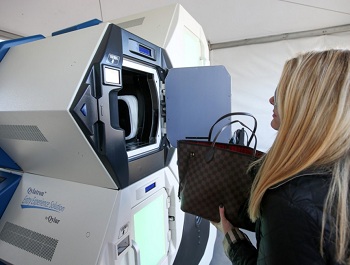An Israeli air force veteran and security consultant has created an innovative new device that could potentially replace x-rays, metal detectors, chemical sensors, and hands-on bag searches at large venues. The honeycombed-shaped device, called the Qylatron Entry Experience Solution, is capable of quickly and accurately scanning bags for contraband and weapons — a single machine can screen five people at a time or 600 per hour.
Lisa Dolev was inspired to create the device in 2004, after watching footage of a terrorist attack in Madrid. After seven years of research and development, the Qylatron device is finally in use at Levi’s Stadium in San Francisco, and the TSA is now considering its use for a variety of security checkpoints, including airports.
The machine is shaped like a high-tech beehive, with hexagonal pods stacked together to process multiple people’s belongings at a time. After placing bags inside a pod, the door locks and uses internal scanners to search the bag — without a human being ever having to open it up and search by hand. In the event of a security flag, the pod would lock itself and call over security personnel. If the bag raises no alarms, it can simply be picked up from the other side of the machine.
The Qylatron is equipped with an artificial intelligence algorithm that “learns” about different objects as the machine is used, helping it distinguish genuine threats from everyday items. For example, in an amusement park the machine might learn to recognize snacks and allow them to pass through, or in a rainy city it could learn to recognize the shape of a folded-up umbrella. In an alcohol-free venue, it could learn to tell if vodka were being smuggled inside a water or soda bottle. Each device is connected wirelessly, so each machine immediately has access to what others across the globe have learned.
The machine can also be set to different levels of security depending on who is using it. Each person has to scan a ticket to the venue or location when they place their bag inside, so the machine can easily tell them apart. It could be programmed not to flag a chef catering an event for carrying knives, while the same objects in a guest’s bag would set off an alert.








